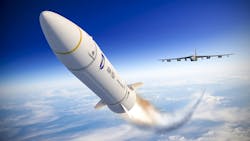Boeing, Lockheed Martin, and Raytheon chosen to develop hypersonic cruise missile and rugged electronics
EGLIN AIR FORCE BASE, Fla. – U.S. Air Force hypersonic munitions experts are looking to three U.S. prime defense contractors to develop a solid-rocket air-breathing hypersonic conventional cruise missile for launch from existing fighter-bomber aircraft.
Officials of the Air Force Life Cycle Management Center at Eglin Air Force Base, Fla., issued a formal notice on Wednesday (FA8682-20-R-0008) concerning upcoming contractor selection for the Future Hypersonics Program.
The contractors are the Boeing Co. Phantom Works in Washington; the Lockheed Martin Corp. Skunk Works segment in Palmdale, Calif.; and the Raytheon Technologies Corp. Missiles & Defense segment in Tucson, Ariz.
Air Force experts will solicit proposals from these three companies to develop an air-launched hypersonic cruise missile, with contract awards to Boeing, Lockheed Martin, and Raytheon sometime this fall.
Related: The electronics design challenges of hypersonic flight
These companies are considered to be the only responsible sources of hypersonic cruise missiles, Air Force officials say. Hypersonic weapons typically travel at Mach 5 to Mach 10 -- or speeds of 3,840 to 7,680 miles per hour.
A missile traveling at Mach 5 could hit a target 100 miles away in about 1 minute and 34 seconds. A missile moving at Mach 10, meanwhile, could hit a target 100 miles away in about 47 seconds. Attempts to defend against incoming missiles traveling at these speeds leave very little time to deploy countermeasures.
One of the most difficult challenges of developing hypersonic weapons involve crafting rugged electronics for guidance and navigation that can withstand the extreme shock, vibration, and heat of hypersonic flight. Moving an object through the air at hypersonic speeds has been likened to a spacecraft re-entering the Earth's atmosphere.
The U.S. Department of Defense (DOD) has identified developing hypersonic munitions -- and the ability to defend against them -- as one of the department's highest priorities. Potential U.S. adversaries China and Russia also are developing hypersonic weapons.
These kinds of super-fast munitions typically will be for high-value targets such as enemy aircraft carriers, relocatable strategic missiles, and forward-deployed military bases.
The contracts will call for an initial effort to systems requirement review, with an option for a follow-on effort that leads to a successful preliminary design review -- all within an approximate 15-month period of performance.
Email questions or concerns about the upcoming Future Hypersonics Program contracts to the Air Force's Lanie Bolin at [email protected]. More information is online at https://beta.sam.gov/opp/e1d5596403234de69edca03f270509f6/view.
For additional information contact Boeing Phantom Works online at https://www.boeing.com/defense/phantom-works/index.page, Lockheed Martin Skunk Works at https://www.lockheedmartin.com/en-us/who-we-are/business-areas/aeronautics/skunkworks.html, Raytheon Missiles & Defense at https://www.raytheonmissilesanddefense.com, or the Air Force Life Cycle Management Center at https://www.aflcmc.af.mil.

John Keller | Editor-in-Chief
John Keller is the Editor-in-Chief, Military & Aerospace Electronics Magazine--provides extensive coverage and analysis of enabling electronics and optoelectronic technologies in military, space and commercial aviation applications. John has been a member of the Military & Aerospace Electronics staff since 1989 and chief editor since 1995.

